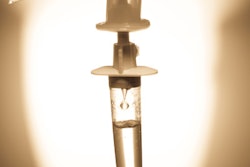
Deep sedation may not be needed for third molar extractions and other invasive procedures, according to a new study. After testing various concentrations of midazolam and propofol on 1,000 people, researchers found 3 mg of each drug worked best for the majority of patients.
While intravenous sedation is usually used safely during dental procedures, there is still a risk of severe adverse effects, including death. Japanese researchers wanted to see if there was an optimal dosage of the common sedation drugs that satisfied both patients and dentists, but also minimized the chance of adverse effects.
"Since sedation is utilized for both the dentist and the patient, the optimal dose should be minimized to prevent adverse effects," wrote the authors led by Rikuo Masuda, DDS, from the Showa University School of Dentistry (PLOS One, February 9, 2017). "We attempted to define the optimal doses of midazolam and propofol required to achieve high levels of patient and dentist satisfaction."
Optimal dosage
When using midazolam and propofol during dental procedures, the dosage needs to be just right. Too little sedation and a patient may remember the operation, but too much and he or she may move unintentionally. The study authors wondered if there was an optimal dosage of both sedation drugs that would please most dentists and patients.
To find out, they recruited 1,000 patients who needed dental procedures under intravenous sedation at the Showa University Dental Hospital in Tokyo. Most patients required surgical dental treatment, including third molar extraction, but others were there for conservative treatment, implant placement, or prosthodontics.
The patients were all at least 20 years old and were classified according to the American Society of Anesthesiologists (ASA) physical classification system as healthy (ASA I) or with mild systemic disease (ASA II). The average patient was 5 feet 3 inches tall and weighed 130 lb. More women than men participated in the study.
A dental anesthesiologist began each procedure by administering 1 mg of midazolam to a patient. The anesthesiologist would then add 1 mg of the drug every minute until the patient exhibited slurred speech or droopy eyes.
Once the patient was adequately sedated, the anesthesiologist used propofol to maintain the sedation level throughout the procedure. Although the dosage of propofol was left to the discretion of the anesthesiologist, it needed to be weak enough that the patient could be roused by verbal commands or physical stimulation, but strong enough to keep the patient from recalling the procedure.
After each procedure, the dentist was given a survey to rate the ease of the surgery and patient compliance. The patients were also asked about their comfort and intraoperative memory once they recovered from the effects of sedation.
The authors found that 3 mg of midazolam and 3 mg/kg/hr of propofol seemed to be the dosage that created the highest patient and doctor satisfaction. Patients tended to experience unwanted memories with lower doses, and dentists complained of "sizable" or "frequent" unintentional movements with higher doses.

The relatively low dosage for all patients resulted in no obvious adverse events, even for a sample size of 1,000 patients. The authors noted that deep sedation may not be needed for all surgical procedures.
"Although the most common sedation level was conscious sedation, most patients were well-satisfied and were discharged from the hospital after a period of approximately 15 minutes without any complications," wrote Dr. Masuda and colleagues. "Deep sedation may not be needed even for invasive produces, such as third molar extractions."
Patient evaluation still required
Even though the study included 1,000 patients, it took place exclusively at one Tokyo hospital, so the results may not be applicable to different places, especially those with populations very different from that of Japan. In addition, the patients were not randomized and the dental anesthesiologists were not blinded to the study, which may have affected the results.
Nevertheless, the findings do suggest that a relatively small dosage of intravenous sedatives may be better than a larger one. However, the authors emphasized that sedation should be done on a case-by-case basis.
"To ensure a loss of intraoperative memory while simultaneously suppressing unintentional movements, the optimal doses of anesthetics should be explored on an individual basis," wrote Dr. Masuda and colleagues. "However, we found that an optimal dose could be fixed even after taking individual variations into consideration."



















